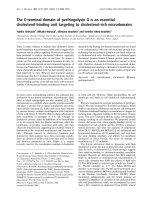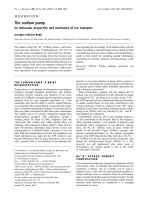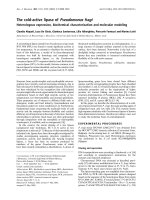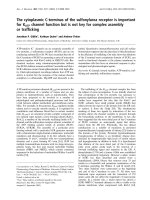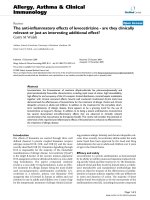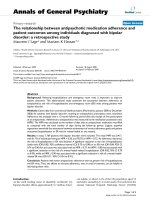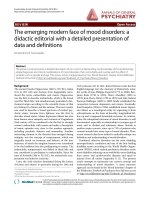Báo cáo y học: "The Little ICU Book of Facts and Formulas" pptx
Bạn đang xem bản rút gọn của tài liệu. Xem và tải ngay bản đầy đủ của tài liệu tại đây (117.16 KB, 1 trang )
Available online />Page 1 of 1
(page number not for citation purposes)
Books now compete with web-based electronic resources,
and the challenge for authors and publishers is how to
provide accurate and timely information with sufficient depth
and breadth to be useful in the workplace. A book of this type
therefore has to compromise between size and detail,
demonstrate balance in selection of material, and appeal to a
globalised world. In many respects, Paul Marino succeeds in
this task.
The book is a condensed version of ‘The ICU Book’ by the
same author. Intended as a compact bedside reference, it is
presented as 15 chapters, each with up to 5 sub-sections.
Chapters cover diverse subjects with an appendix of
conversion tables, normal values and formulae. Algorithms
are well referenced using current evidence.
However, these strengths are offset by some notable
omissions and imbalances. The haemodynamic monitoring
section is exclusively based on the pulmonary artery flotation
catheter (PAFC), disregarding other forms of monitoring - for
example, oesophageal Doppler, LiDCO™ or PiCCO™. No
reference is made to evidence regarding lack of clinical utility
of the PAFC. The section on haemodynamic drugs lacks
breadth, omitting discussion of epinephrine, vasopressin
(mentioned briefly in the septic shock chapter), phospho-
diesterase inhibitors or levosimendan. Sodium nitroprusside,
however, receives four pages.
The chapter on vascular access mentions the importance of
aseptic technique, stating that handwashing, sterile gloves
and full barrier precautions are ‘recommended’ for central
venous catheter (CVC) insertion. A simple table mandating
such measures would have greater impact, including the use
of alcoholic chlorhexidine and a catheter cart facilitating prior
preparation. There is no reference to the use of ultrasound
guided CVC insertion. Conversely, there is an unnecessary
page describing peripheral intravenous cannulation.
The toxicology chapter omits important aspects of self-
poisoning, namely tricyclic antidepressants and drugs of
abuse. The chapter on antimicrobial therapy would have been
improved by repeating the Surviving Sepsis Campaign
recommendations in the septic shock section and by
referencing the website, rather than the now outdated 2004
recommendations. Daily review and early termination of
antimicrobials should be emphasised.
The sequences of chapters and topic choices are disjointed.
Topics including illness severity scoring, morbidity, mortality
and treatment withdrawal would have been useful. Non-SI
units in many equations make conversions inconveniently
necessary for the European reader. The book is positioned as
a primer in the basics of North American intensive care
medicine. It is not entirely harmonised with European practice
and readers may consider alternatives. That said, trainees
would find it a handy reference at the ICU workstation.
Competing interests
The authors delare that they have no competing interests.
Book report
The Little ICU Book of Facts and Formulas
Som Sarkar
1
and Julian Bion
2
1
Specialist Registrar in Anaesthesia and Intensive Care Medicine, University Hospital Birmingham NHS Foundation Trust,
Birmingham, B15 2TH, UK
2
Professor of Intensive Care Medicine, University Department Anaesthesia and ICM, N5, Queen Elizabeth Hospital,
Edgbaston, Birmingham, B15 2TH, UK
Corresponding author: Julian Bion,
Published: 19 May 2009
Critical Care 2009, 13:304 (doi:10.1186/cc7764)
This article is online at />© 2009 BioMed Central Ltd
Paul L Marino: The Little ICU Book of Facts and Formulas. Philadelphia: Lippincott Williams and Wilkins, 2009,
800pp., ISBN 978-0-7817-7823-7

